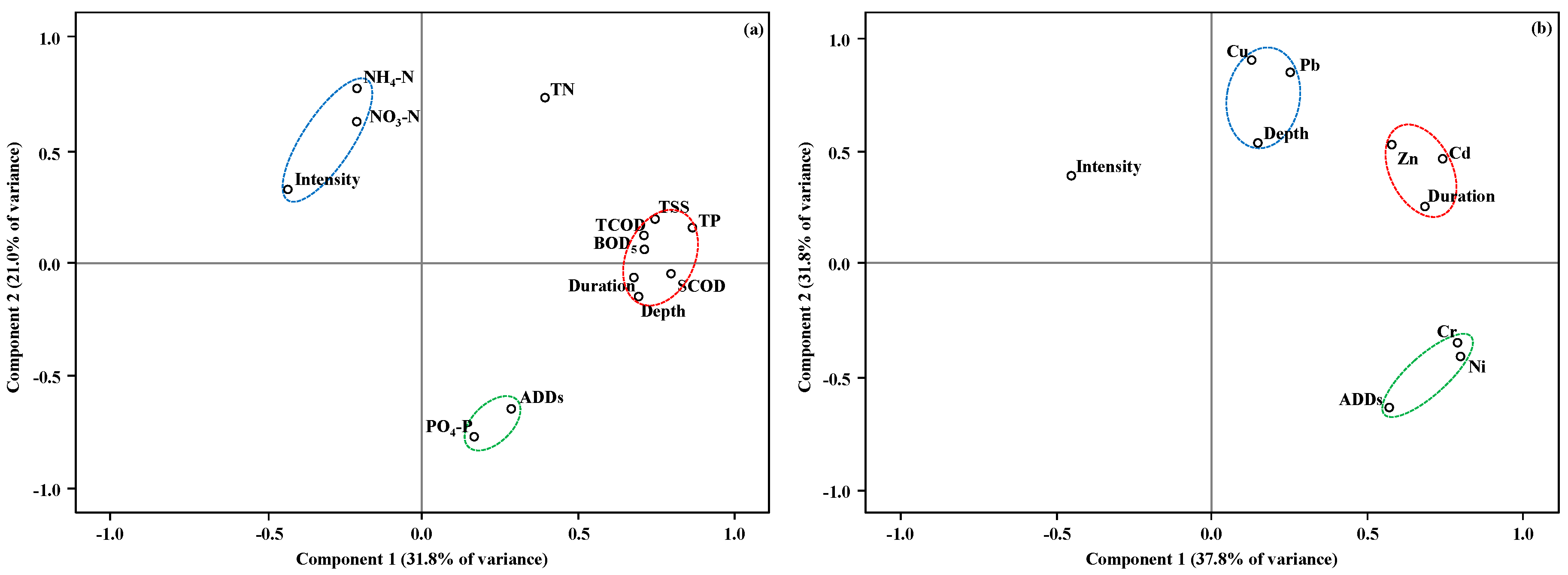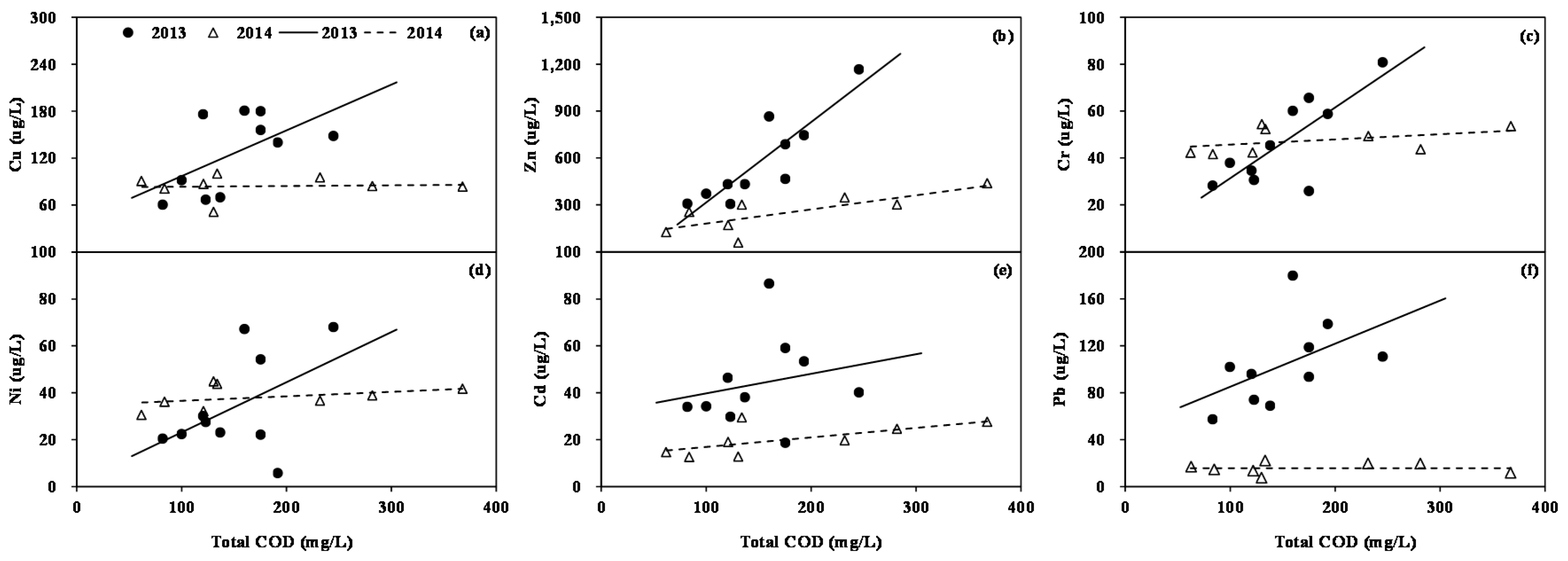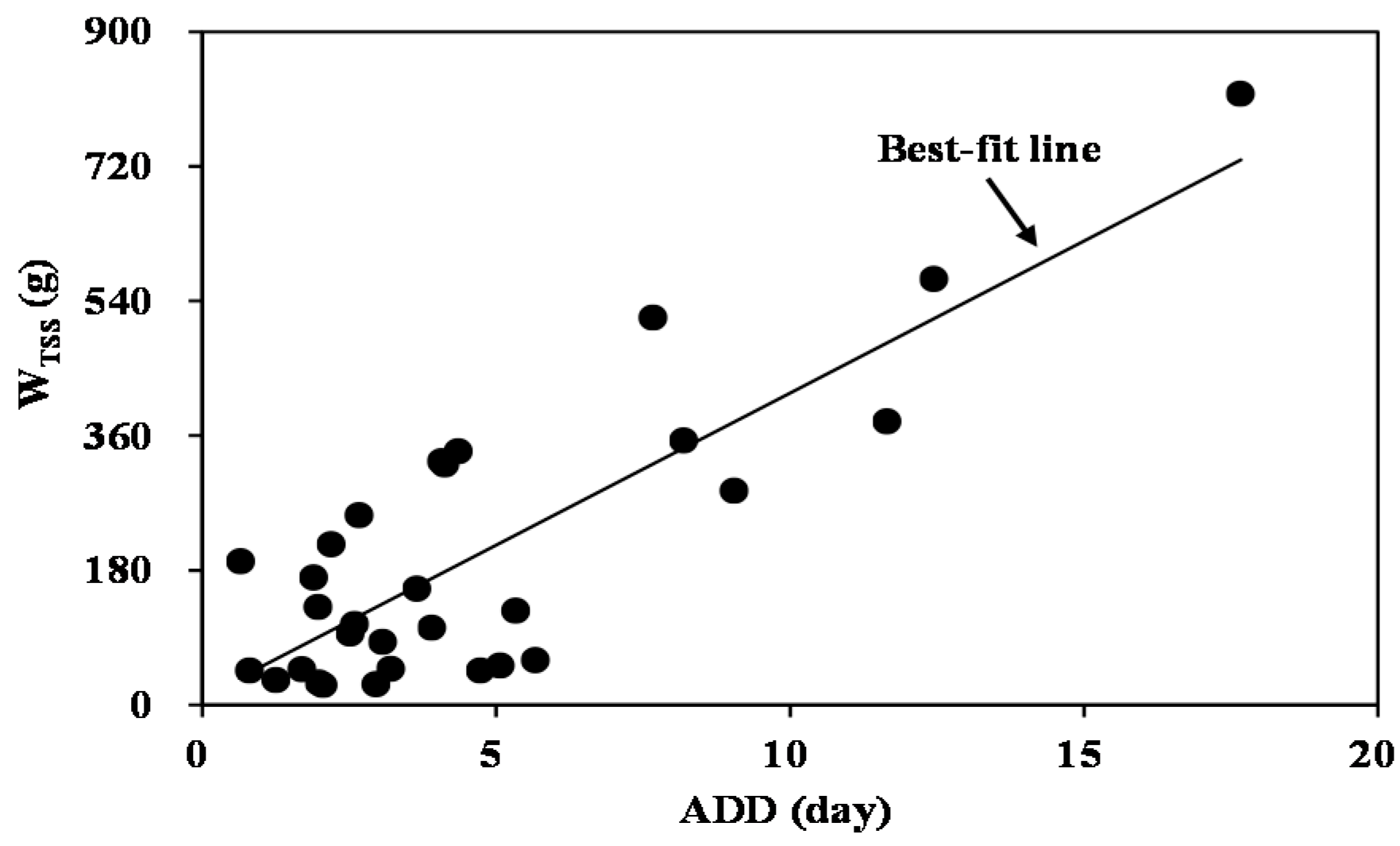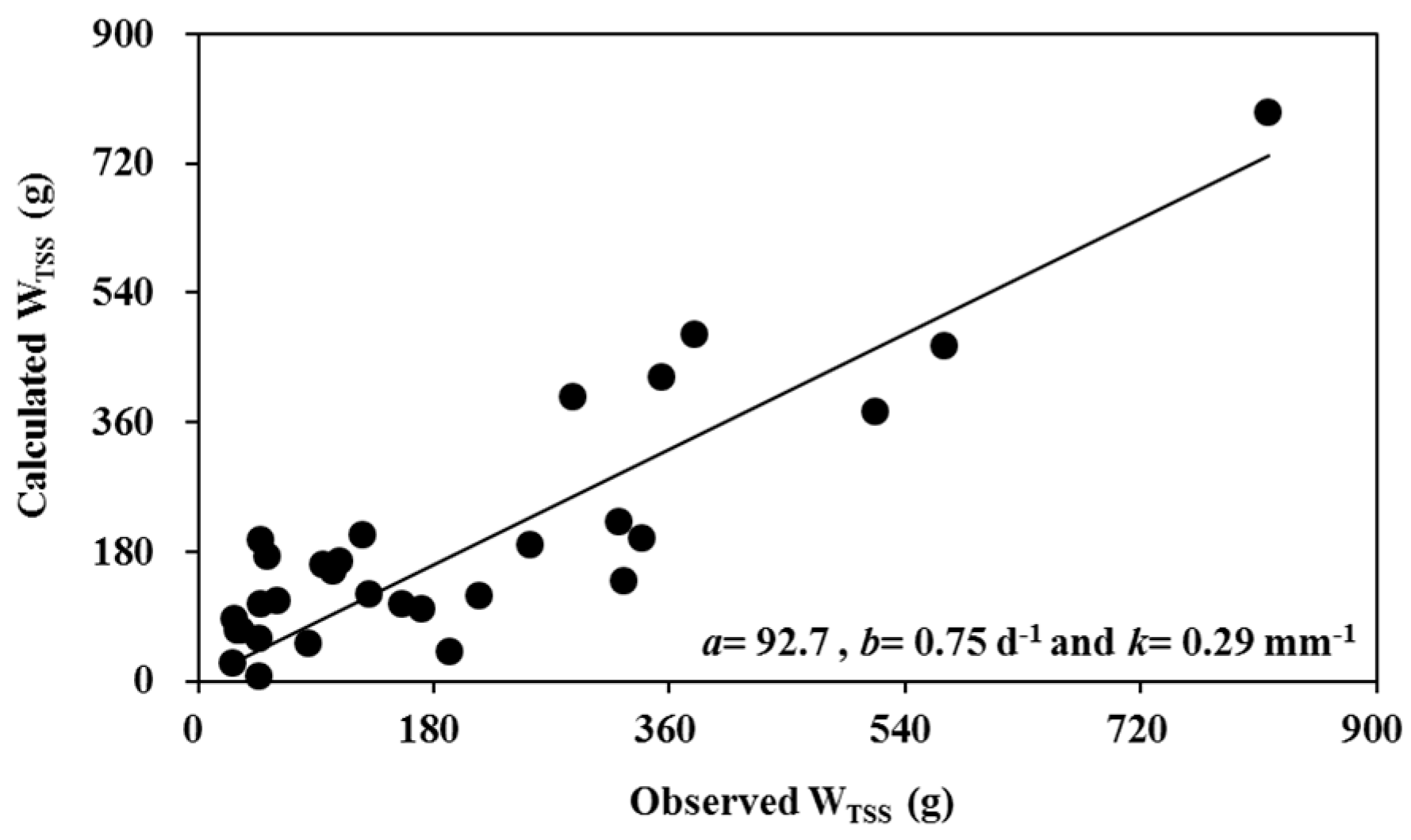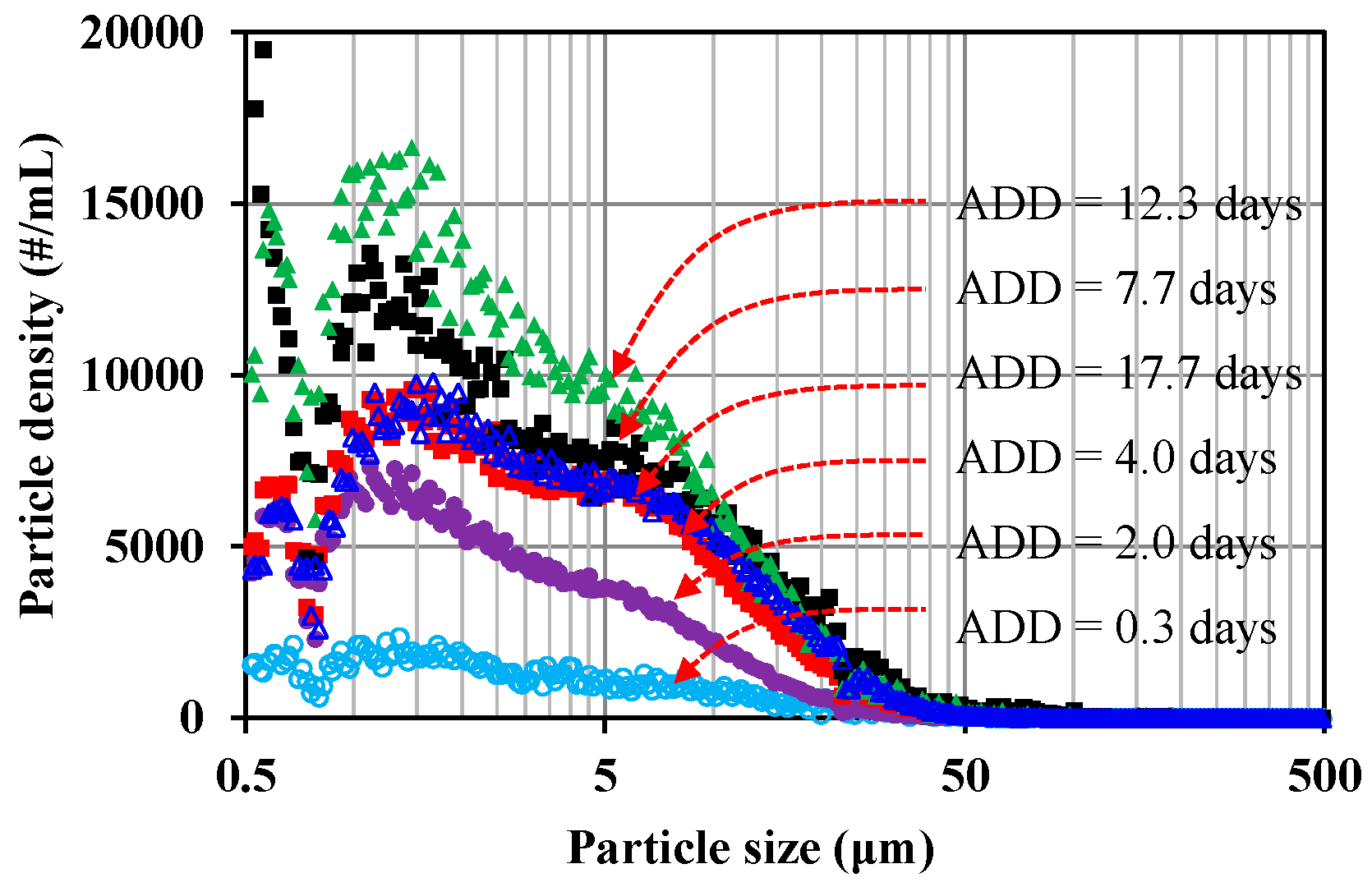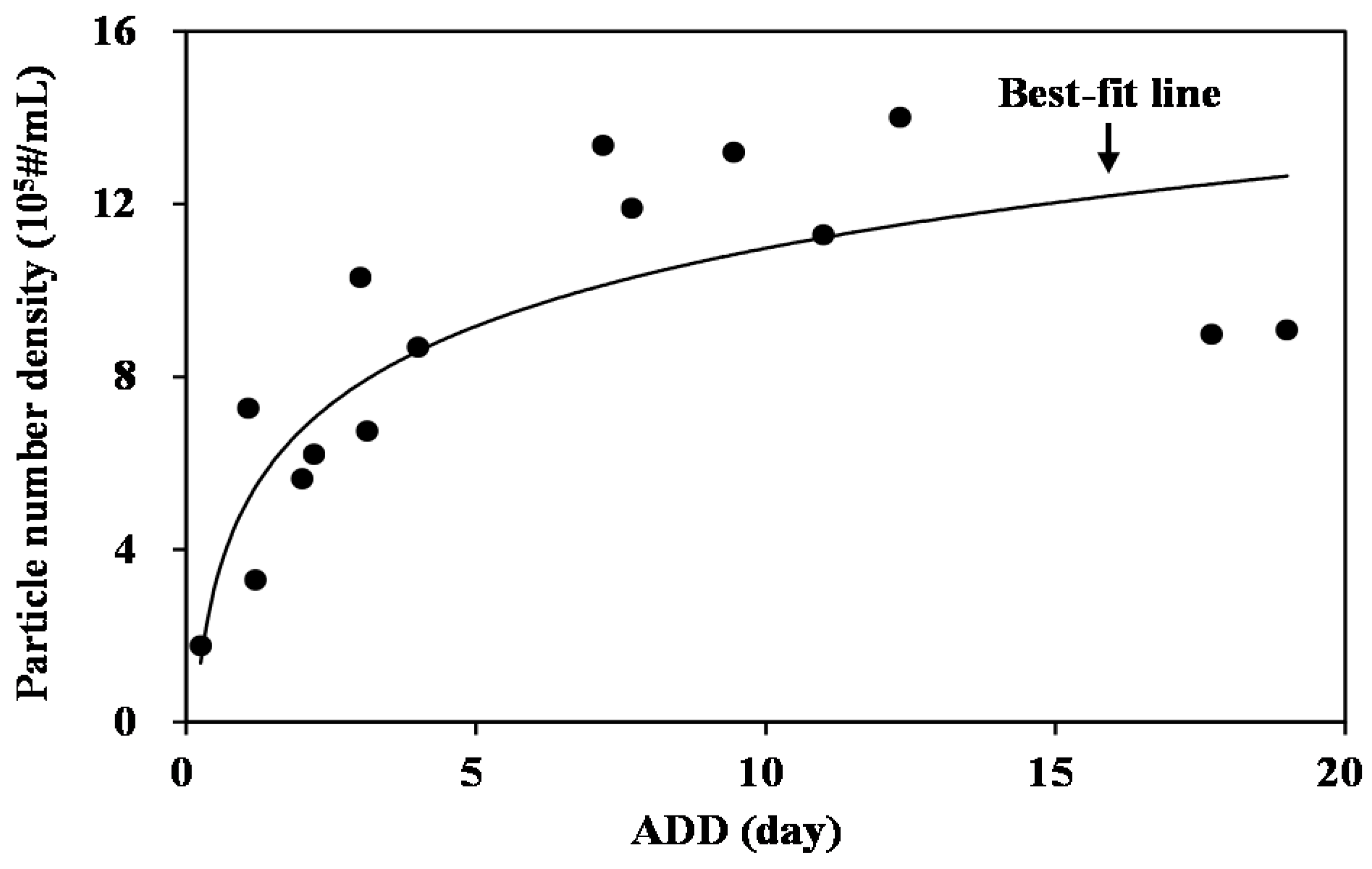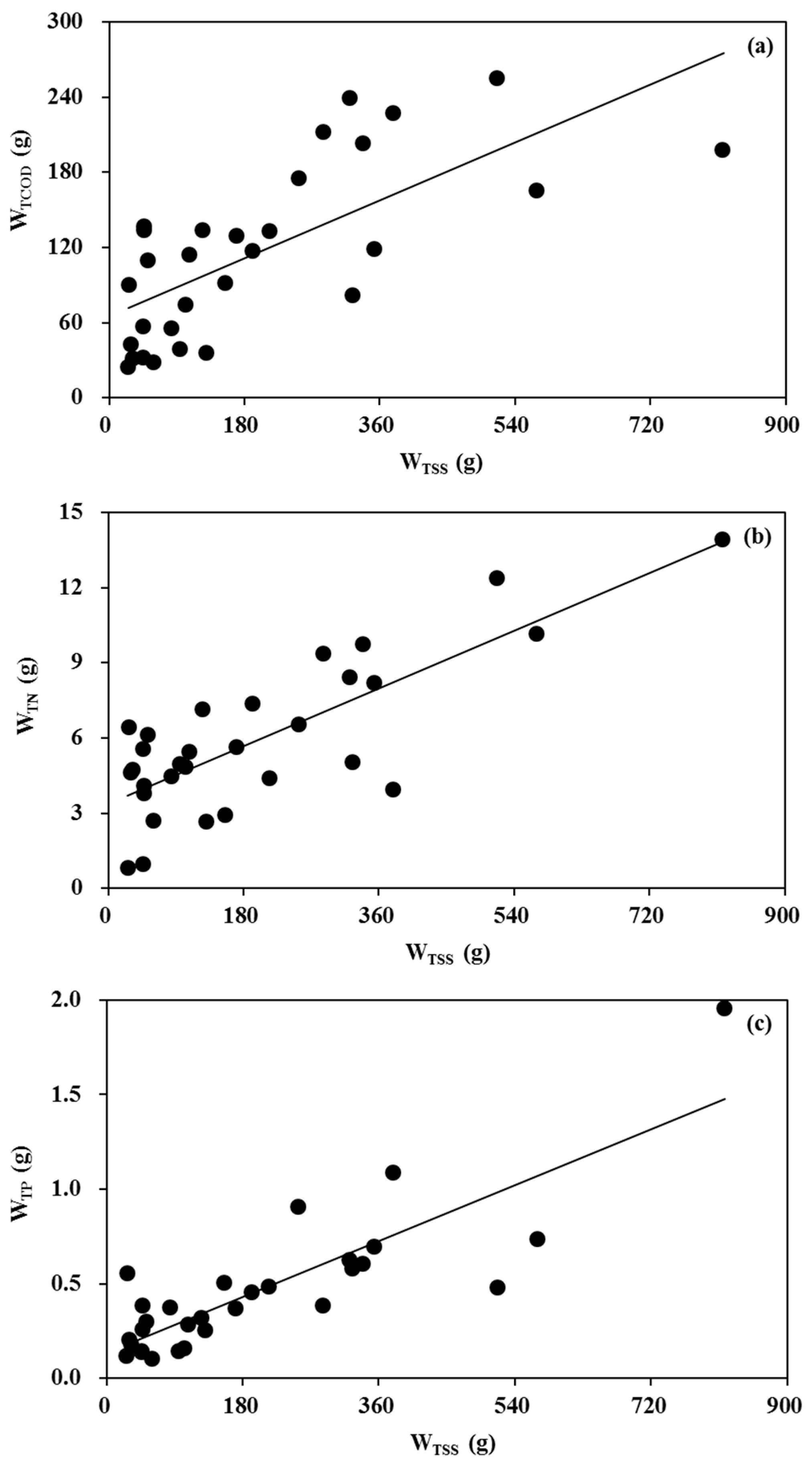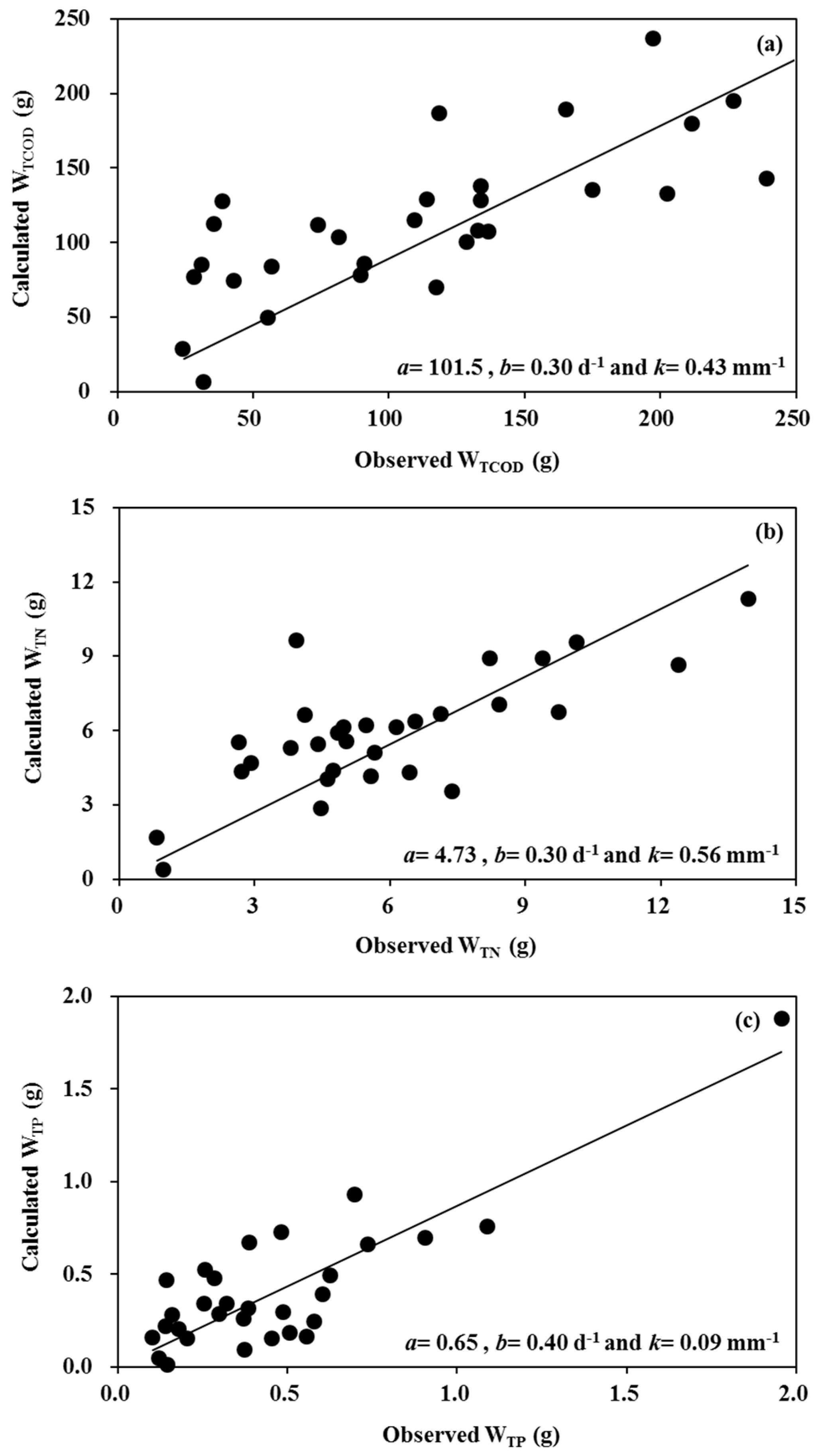3.1. Effect of Rainfall Conditions on Pollutant Concentration
Based on past observation, and as a result of the insignificant relationship between traffic volume and pollutants in stormwater, multiple rainfall conditions including ADDs, rainfall depth, intensity and duration can be considered as major influential factors. However, the effects as well as the extent of impact on water quality parameters differed from a single rainfall event. Therefore, with the identification of such a multitude of factors, factor analysis was adopted to statistically describe variability among the observed variables.
As shown in
Figure 2a, dissolved contaminants including ammonia and nitrate were highly correlated with rainfall intensity. This could have been a consequence of leached-out soluble matter from particles during intensive rainfall, and also confirmed the work by Novotny and Olem [
11].
It was found that PO
4-P was more related to ADDs. This was primarily caused by the amount of atmospheric deposition over dry days. As it can be easily and readily adsorbed, phosphate is easily transported by airborne particulates. However, the formation of atmospheric aerosol and dust plumes is subject to rainfall frequency [
12]. Therefore, longer durations of dry weather periods provide a greater chance for phosphate to associate with particles, resulting in a considerable deposition of phosphate on road. Additionally, except for dry deposition, PO
4-P from the atmosphere can be also washed-off to road surface during rainfall. Therefore, a significant relationship was detected between PO
4-P and ADDs.
With regard to conventional water quality parameters, TSS, TCOD, SCOD, TP and BOD5 were significantly affected by rainfall duration and depth. The increased duration and depth resulted in bulk stormwater, thus causing the suspension of pollutants from paved road. It is noteworthy that the EMCs of particle-associated pollutants which are generally related with ADDs, were more affected by rainfall duration and depth in this study. This is ascribed to the limited source of particles on the pavement surface. As most of the particles were washed out in the initial phase of rainfall, the increased runoff volume could have been the affecting factor for decreasing particle concentration. In addition, this result also implies that the particles in the studied area might be small enough to be readily transported by stormwater.
Nitrogen was not affected by any rainfall conditions. Since nitrogen constituents in stormwater can be transformed randomly, particulate nitrogen can be converted into soluble form, or from one dissolved nitrogen form to another. Accordingly, the effect of rainfall conditions on nitrogen can be arbitrary.
For heavy metals, the results shown in
Figure 2b indicated that rainfall depth was affected the lead and copper. Additionally, it was also found that zinc and cadmium were determined by the rainfall duration, while the EMCs of chromium and nickel were notably affected by the ADDs. The metals accumulated on paved road, and most were derived from atmospheric deposition, worn off vehicle accessories, or detached from paved materials. Once they have deposited on the road surface, their chemical speciation and transformation could be subject to their own sources and characteristics.
For instance, the most common oxidation state for lead in the environment is +2, which is more stable than the +4 state. Accordingly, lead salts (+2) are slightly soluble and likely to combine closely with particles, especially smaller ones [
13]. The particulate-bound pollutants tended to be source-limited in the present studied area. Therefore, as the storm continued, most of the fine-sized particulates washed off from the road surface, and increased rainfall depth was a potential factor for diluting the lead concentration. Additionally, since most solids in nature are negatively charged, they can bind and release positively charged ions in solution. In contrast to the lead present in stormwater, copper, zinc and cadmium have a complex range of phases. Hence, the increased rainfall duration and depth provided more runoff volume to dissolve them from solid form. With respect to chromium and nickel, which mainly originated from atmospheric deposition [
11], the amount of their accumulation in air was greatly determined by the interval between rainfalls. Therefore, their concentration was closely related with ADDs. As a result, the different impacts of rainfall conditions were associated with the diverse characteristics and sources of selected metals.
3.2. The Relationship between COD and BOD5
TCOD and BOD
5 are common water quality parameters for measuring various organic compounds in stormwater runoff. COD is used to determine the total quantity of oxygen required to oxidize all organic material, whereas BOD is a measure of the amount of oxygen required for microorganisms to degrade the organic components present in stormwater. Hence, the BOD
5 content is directly proportional to COD concentration [
14].
Based on the data investigated from 2013 and 2014, it was observed that BOD
5 concentration decreased with increasing total COD concentration in 2013 (
Figure 3a). Conversely, it increased as the total COD concentration increased during 2014 (
Figure 3b). The different result between the two years was related to differences in the level of toxic matter present in the stormwater runoff, which can inhibit the growth of microorganisms. For the stormwater from the paved road in particular, high levels of heavy metals pose a potential risk to aquatic microorganisms due to their toxicity [
15].
Figure 4 shows the relationship between the selected metals (Cu, Zn, Ni, Cd, Cr and Pb) and total COD concentrations during 2013 and 2014. It was found that the concentrations of heavy metals increased as COD concentration increased, especially during 2013.
Typically, half-maximal effective concentration (
EC50) is used to determine the concentration of a compound which can exhibit a response to 50% of the microorganism population. Comparing the 2013 and 2014
EC50 data, it was observed that most of the selected metals had higher concentrations in 2013 than those in 2014 (
Table 2). In particular, zinc, cadmium and lead were likely to exceed the
EC50 value in some cases. This means that the stormwater in 2013 might have a higher toxicity because of the higher level of heavy metals (Zn, Cd and Pb). Therefore, as the COD concentration exceeded a specific value, the excessive level of heavy metals provided a potential effect on the growth of microorganisms, resulting in a decrease of BOD
5 (2013 data). This result also suggests that the obtained relationship of the BOD
5 and COD could be used as an alternative indicator for stormwater toxicity. Additionally, the higher level of metals in 2013 than that of 2014 might be ascribed to the relatively higher amount of wet deposition, resulting from different precipitation in 2013 (1518 mm) and 2014 (945 mm).
3.3. Effect of Number of Dry Days on the Washed-Off Particles
Normally it would be expected that the amount of solids deposited over the paved road increases as the dry period persists [
18]. This means that the mass of solids resulted from the rainfalls was directly proportional to the number of antecedent dry days. Hence, the build-up of solids during dry days can be modeled as a power function given as below:
where ADD (day) is number of dry days, a, b are empirical model parameters.
During the last few decades, numerous empirical functions of the pollutant washed-off from impervious pavement were proposed, and are now typically expressed in terms of a first-order removal process. Among them, the simplest and most widely used empirical model proposed by Sartor et al. [
19] is based on rainfall intensity and duration.
In the model, W (g) is the wash-off load, W0 (g) is the initial mass of solids on the catchment surface, k (mm−1) is the wash-off coefficient, I (mm/h) is the rainfall intensity, and t (h) represents the duration of rainfall. If W0 which represents amount of solids deposited before rainfall starts is proportional to the build-up (B) in Equation (1), Equation (2) can be approximated as Equation (3).
In this study, it was found that the washed-off load of TSS was significantly correlated with incremental antecedent dry weather periods (
Figure 5), suggesting that ADDs could be one of the affecting factors in the wash-off process.
To determine the potential effect of ADDs on the wash-off process, Equation (3) was employed for modelling. Both the calculated and observed masses of washed-off solids were plotted in
Figure 6.
The empirical model exerted a great influence on modelling washed-off load. This confirms that scoured solids from rainstorms are not only determined by specific rainfall variables (rainfall intensity and duration), but are strongly related to the accumulation time.
It is noteworthy that the results were not consistent with previous findings stating that the pollutant wash-off has a great impact on pollutant load present in runoff, while pollutant build-up has only a minor effect [
8,
20,
21,
22]. The possible reason for these different observations could be related to the specific size of accumulated solids.
In this study, the particle size distribution (PSD) of runoff was investigated for the independent rainfall events and the results are given in
Figure 7. According to
Figure 7, it is evident that fine particles smaller than 30 μm are mostly predominant in the runoff, regardless of the number of dry days, while their density tends to increase when the length of the dry weather period increases. However, it should be mentioned that the highest number of particles was not found when the dry weather period over 17 days, indicating that longer dry days may provide more opportunity for some of the accumulated particles from road surface to be removed [
8].
To determine the relationship between the number of dry days and particle density, total particle count was plotted with respect to the duration of the dry weather period. As exhibited in
Figure 8, it was clearly observed that the density of washed-off particles is positively related with the dry day span.
This observation was confirmed by the increment of W
TSS in terms of increasing period of dry weather as provided in
Figure 5. Generally, the enhanced TSS concentration was significantly correlated with the particle density increase. The high density of the particles was accounted for, as substantial suspended solids appeared in the stormwater. Therefore, the W
TSS increased as the number of particle increased over increasing dryness. This outcome revealed that the relationship between density of washed-off particulate and ADDs is closely related with the deposition of dust and dirt on road surface.
Unlike the linear increase of W
TSS, the particle density showed a trend approaching equilibrium during increasing dry days. Over the accumulation process, wind and traffic-induced air turbulence constantly moved particulates away from the pavement [
11]. The fine particle fraction was readily removed, and replaced by other shifted particles. Therefore, a dynamic equilibrium of deposited particles occurred after a certain period.
The redistribution effect was more significant for finer particles than coarser ones. Among the range of predominant particles (<30 μm), the finer particle fraction contributed a larger proportion of particle number, whereas the relative coarser fraction mostly affected the amount of suspended solids. Therefore, particle density was positively related with ADD until it reached equilibrium. Regardless of the different trends, these outcomes implied that the particles washed-off after a specific storm event can be greatly influenced by initially accumulated particulates at the end of dry weather periods.
The fine particles (<30 μm) accounted for more than 90% of the total washed off particulates. Hence, these fine particles prominently influence the amount of accumulated solids from road surface during increasing antecedent dryness. During the rainfall, less energy is needed for suspending and mobilizing fine-sized accumulated solids from pavement. The W0 parameter depends on the ADDs and thereby is the limiting factor of the wash-off process. As a result, the mass of washed-off particles over the duration of storm event can be closely determined by the length of antecedent dry weather period in this study site.
The predominant fraction of road-deposited solids is a complex problem that relates to various environmental factors in different areas. Vaze and Chiew [
8] found that particles less than 300 μm were predominant in their place of study; Egodawatta and Goonetilleke [
20] noted that particles finer than 100 μm had the largest fraction on studied pavements, and Wijesiri et al. [
22] studied that the greatest wash-off load was composed mainly of particle size fractions less than 150 μm. Among these studies, the predominant particles were relatively coarser than those of the present study. Even though the particulate build-up pattern in each study followed a similar trend, the transport and mobilization of coarser particles was mainly controlled by the splashing effect of rain drops, and the shearing force of flows. Therefore, rainfall intensity and duration were defined as the influencing factors in those studies.
3.4. Effect of Number of Dry Days on the Amount of Wash-Off Pollutants
Pollutants associated with deposited solids from paved road have been identified in numerous studies. Furthermore, pollutant affinity for particles is significantly correlated with different particle size ranges. Typically, a considerable amount of pollutants have a tendency to combine with fine-sized particulate, due to their larger superficial area.
As shown in
Figure 9, the mass of TCOD, TN and TP were proportionally related with the amount of TSS in stormwater. The good correlation between selected pollutants and suspended solids was due to the predominantly fine-sized particles occurring on the road surface. As mentioned earlier, the mass of washed-off solids greatly depended on the duration of antecedent dry weather periods. Therefore, the wash-off of particle-related pollutants is also expected to be subject to the ADDs effect.
In order to verify our hypothesis, the rainfall conditions (ADDs, rainfall duration and intensity) corresponding to the 30 rainfall events were substituted into Equation (3). The comparison between calculated values of pollutant load and observed load are provided in
Figure 10 to evaluate the calculation accuracy of the empirical model. The Figure showed a good performance on estimating the mass of washed-off pollutant, revealing that ADDs is an influential factor for pollutant washed-off. It was observed that TP gave fine regressions (R
2 = 0.71). The index of ADDs gave an obviously higher wash-off coefficient, suggesting that the wash-off of phosphorus was mainly controlled by the antecedent dry period.
Typically, phosphate is the most dominant form of phosphorus in deposited particulates originating from paved-roads, and mainly combines with fine particles [
18]. Unlike other ion species (e.g., nitrate, nitrite), PO
43− ions are only slightly mobile and cannot be readily leached out from the associated solids [
11]. Thus, rainfall characteristics have less of an influence on phosphorus transport. Fine-sized particulates were significantly correlated with ADDs, thereby being regarded as the most influential factor for washed-off phosphorus in this study.
Relatively weak relationships between calculated and observed values were found in TN and COD (R2 = 0.30, 0.35). In addition, it was observed that the wash-off coefficients are slightly higher than the index of ADDs among the models. The results in organic matter and nitrogen are not consistent with that of phosphorus, relating with the different characteristics of these pollutants.
In the current study, organic nitrogen occupied 64% of total nitrogen, which plays a role as the predominant nitrogen species in the study site. As such, pollutants with high organic matter content on the road pavement can be greatly influenced by photo-oxidation, volatilization and natural decay with exposure to sunlight [
23]. Therefore, increased ADDs may provide an opportunity to decrease some pollutants.
After the storm ceases, the road surface can still be wet, allowing some pollutants to accumulate on the pavement. Hence, substantial pollutants can closely adhere on the road during the paved surface’s drying period. During the wash-off process, stormwater flows across the road surface and wets fixed solids, thereby causing solubilization and desorption of some constituents from the particulate and the pavement. Furthermore, organics and nitrogen have more complicated components and transposition mechanisms [
24]. The enhanced intensity and longer duration of rainstorms results in increasing runoff volume, providing more chances and possibilities to transform them from solid form to other forms [
13,
22]. Therefore, this variability in the build-up and wash-off process results in relatively poor modelling performance.

